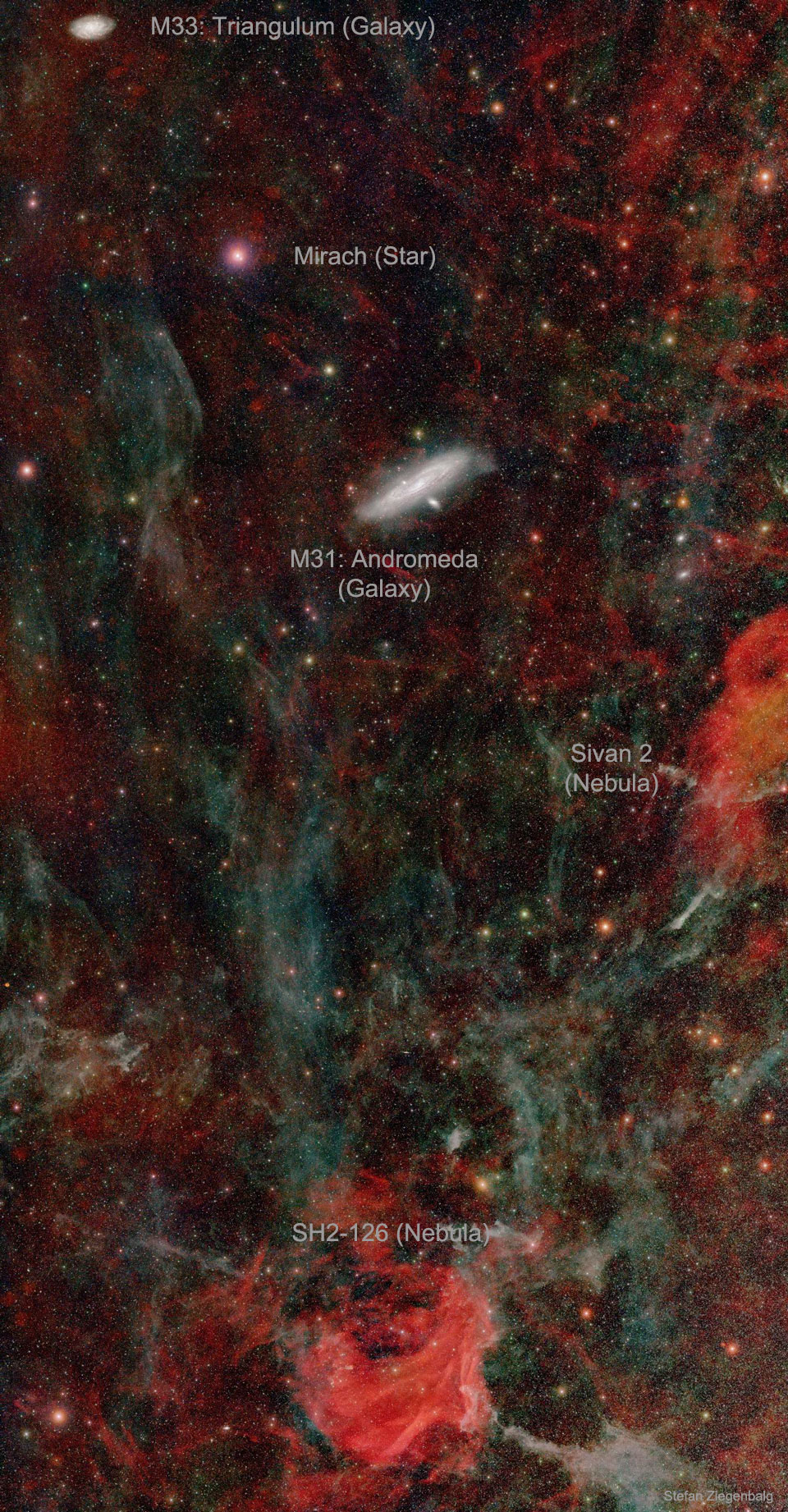08. September 2021
仙女座星系 ê 深空

探索宇宙1!逐工會揀一幅無仝款 ê 影像抑是相片,𤆬你熟似咱這个迷人 ê 宇宙,閣有專業天文學者2為你解說3。
- 原始文章:The Deep Sky Toward Andromeda
- 影像來源 kah 許可:Stefan Ziegenbalg
- 台文翻譯:An-Li Tsai (NCU)
[漢羅] 仙女座星系 ê 深空
是啥物 kā 仙女座星系圍–leh? Tī 太空中,仙女座 (M31) 去予幾若个較細 ê 衛星星系 kā 圍–leh。 若是搝較遠來 kā 看,伊是 倚近 本地星系團。 咱 ê 銀河系嘛是其中一个成員。 毋閣 tī 天頂,咱銀河系 ê 氣體雲看起來敢若 kā M31 圍–leh。 這 kah 地球大氣層 內底 水做 ê 雲 kā 月球 圍–leh,敢若有相-siâng。 是講,仙女座星系 ê 氣體雲 傷暗矣,煞看無。 若是軁入去這張 趨 45 度、搝長 ê 影像 內底,to̍h 會當看著有史以來 tùi 寬闊 ê 仙女座天區 上長時間感光 ê 影像。 這張影像 tùi 水素氣體發出 ê 光 特別敏感,有展示較暗、較毋捌看過 ê 雲 足濟細節。 毋閣這張影像毋若翕著按呢。 影像頂懸是 三角座星系 (M33),是 本地星系團 第 3 大 ê 星系,嘛是用目睭 to̍h 直接看有 ê 上遠 ê 天體。 M33 下跤彼粒,較光較紅 ê,是銀河內底 ê 恆星,仙女座 β。 這張影像是 kā tī 德國 Pulsnitz ùi 2018 到 2021 年內底 幾若擺 長時間感光 ê 相片,用數位合成 ê 方式疊做一張 ê。
[POJ] Sian-lú-chō seng-hē ê Chhim-khong
Sī siáⁿ-mih kā Sian-lú-chō seng-hē ûi–leh? Tī thài-khong tiong, Sian-lú-chō (M-saⁿ-cha̍p-it) khì hō͘ kúi-ā-ê khah-sè ê ūi-chhiⁿ-seng-hē kā ûi–leh. Nā-sī giú-khah-hn̄g lâi kā khòaⁿ, i sī óa-kīn Pún-tē-seng-hē-thoân. Lán ê Gîn-hô-hē mā-sī kî-tiong chi̍t-ê sêng-goân. M̄-koh tī thiⁿ-téng, lán Gîn-hô-hē ê khì-thé-hûn khòaⁿ–khí-lâi ká-ná kā M-saⁿ-cha̍p-it ûi–leh. Che kah Tē-kiû tōa-khì-chân lāi-té chúi chò–ê hûn kā Goe̍h-kiû ûi–leh, ká-ná ū sio-siâng. Sī-kóng, Sian-lú-chō seng-hē ê khì-thé-hûn siūⁿ-àm ah, soah khòaⁿ-bô. Nā-sī nǹg-ji̍p-khì chit-tiuⁿ chhu sì-cha̍p-gō͘ tō͘, giú-tn̂g ê iáⁿ-siōng lāi-té, to̍h ē-tàng khòaⁿ-tio̍h iú-sú í-lâi tùi khoan-khoah ê Sian-lú-chō thian-khu siōng-tn̂g sî-kan kám-kng ê iáⁿ-siōng. Chit-tiuⁿ iáⁿ-siōng tùi chúi-sò͘ khì-thé hoat-chhut ê kng te̍k-pia̍t bín-kám, ū tiān-sī khah àm, khah m̄-bat khòaⁿ-kòe ê hûn chiok-chōe sè-chiat. M̄-koh chit-tiuⁿ iáⁿ-siōng m̄-nā hip-tio̍h án-ne. Iáⁿ-siōng téng-koân sī Saⁿ-kak-chō seng-hē (M-saⁿ-cha̍p-saⁿ), sī Pún-tē-seng-hē-thoân tē-saⁿ-tōa ê seng-hē, mā-sī iōng ba̍k-chiu to̍h ti̍t-chiap khòaⁿ-ū ê siōng-hn̄g ê thian-thé. M-saⁿ-cha̍p-saⁿ ē-kha hit-lia̍p, khah kng khah âng ê, sī Gîn-hô lāi-té ê hêng-chhiⁿ, Sian-lú-chō beta. Chit-tiuⁿ iáⁿ-siōng sī kā tī Tek-kok Pulsnitz ùi jī-khòng-it-pat kàu jī-khòng-jī-it nî lāi-té kúi-ā-pái tn̂g-sî-kan kám-kng ê siòng-phìⁿ, iōng só͘-ūi-ha̍p-sêng ê hong-sek tha̍h-chò chit-tiuⁿ ê.
[KIP] Sian-lú-tsō sing-hē ê Tshim-khong
Sī siánn-mih kā Sian-lú-tsō sing-hē uî–leh? Tī thài-khong tiong, Sian-lú-tsō (M-sann-tsa̍p-it) khì hōo kuí-ā-ê khah-sè ê uī-tshinn-sing-hē kā uî–leh. Nā-sī giú-khah-hn̄g lâi kā khuànn, i sī uá-kīn Pún-tē-sing-hē-thuân. Lán ê Gîn-hô-hē mā-sī kî-tiong tsi̍t-ê sîng-guân. M̄-koh tī thinn-tíng, lán Gîn-hô-hē ê khì-thé-hûn khuànn-khí-lâi ká-ná kā M-sann-tsa̍p-it uî–leh. Tse kah Tē-kiû tuā-khì-tsân lāi-té tsuí tsò–ê hûn kā Gue̍h-kiû uî–leh, ká-ná ū sio-siâng. Sī-kóng, Sian-lú-tsō sing-hē ê khì-thé-hûn siūnn-àm ah, suah khuànn-bô. Nā-sī nǹg-ji̍p-khì tsit-tiunn tshu sì-tsa̍p-gōo tōo, giú-tn̂g ê iánn-siōng lāi-té, to̍h ē-tàng khuànn-tio̍h iú-sú í-lâi tuì khuan-khuah ê Sian-lú-tsō thian-khu siōng-tn̂g sî-kan kám-kng ê iánn-siōng. Tsit-tiunn iánn-siōng tuì tsuí-sòo khì-thé huat-tshut ê kng ti̍k-pia̍t bín-kám, ū tiān-sī khah àm, khah m̄-bat khuànn-kuè ê hûn tsiok-tsuē sè-tsiat. M̄-koh tsit-tiunn iánn-siōng m̄-nā hip-tio̍h án-ne. Iánn-siōng tíng-kuân sī Sann-kak-tsō sing-hē (M-sann-tsa̍p-sann), sī Pún-tē-sing-hē-thuân tē-sann-tuā ê sing-hē, mā-sī iōng ba̍k-tsiu to̍h ti̍t-tsiap khuànn-ū ê siōng-hn̄g ê thian-thé. M-sann-tsa̍p-sann ē-kha hit-lia̍p, khah kng khah âng ê, sī Gîn-hô lāi-té ê hîng-tshinn, Sian-lú-tsō beta. Tsit-tiunn iánn-siōng sī kā tī Tik-kok Pulsnitz uì jī-khòng-it-pat kàu jī-khòng-jī-it nî lāi-té kuí-ā-pái tn̂g-sî-kan kám-kng ê siòng-phìnn, iōng sóo-uī-ha̍p-sîng ê hong-sik tha̍h-tsò tsit-tiunn ê.
[English] The Deep Sky Toward Andromeda
What surrounds the Andromeda galaxy? Out in space, Andromeda (M31) is closely surrounded by several small satellite galaxies, and further out it is near to the Local Group of Galaxies – of which our Milky Way galaxy is a member. On the sky, however, gas clouds local to our Milky Way appear to surround M31 – not unlike how water clouds in Earth’s atmosphere may appear to encompass our Moon. The gas clouds toward Andromeda, however, are usually too faint to see. Enter the featured 45-degree long image – one of the deeper images yet taken of the broader Andromeda region. This image, sensitive to light specifically emitted by hydrogen gas, shows these faint and unfamiliar clouds in tremendous detail. But the image captures more. At the image top is the Triangulum galaxy (M33), the third largest galaxy in the Local Group and the furthest object that can be seen with the unaided eye. Below M33 is the bright, red, Milky-Way star named Mirach. The image is the digital accumulation of several long exposures taken from 2018 to 2021 from Pulsnitz, Germany.
詞彙學習(漢羅/POJ/KIP/華語/English)
- 【仙女座星系】Sian-lú-chō seng-hē/Sian-lú-tsō sing-hē/仙女座星系/the Andromeda galaxy
- 【本地星系團】Pún-tē-seng-hē-thoân/Pún-tē-sing-hē-thuân/本地星系團/the Local Group of Galaxies
- 【三角座星系】Saⁿ-kak-seng-hē/Sann-kak-sing-hē/三角座星系/Triangulum galaxy
- 【仙女座 β】Sian-lú-chō beta/Sian-lú-tsō beta/仙女座 β/Mirach
- 【衛星星系】ūi-chhiⁿ-seng-hē/uī-tshinn-sing-hē/衛星星系/satellite galaxies
- 【水素】chúi-sò͘/tsuí-sòo/氫/hydrogen